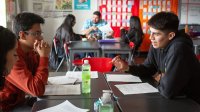Using Oral History Projects to Boost SEL
When middle and high school students listen to each other tell their stories, they build stronger relationships—a key part of social and emotional learning.
Your content has been saved!
Go to My Saved Content.The Covid-19 pandemic has taught us so much about the lack of connection and personal engagement that many of our students experience at school, even as most of us have returned to in-person programming. The need for social and emotional learning (SEL) is greater than ever.
At Voice of Witness, a nonprofit that works to amplify the voices of people impacted by and fighting against injustice, we have found that oral history–based activities are a powerful tool for building SEL skills through sharing stories and active listening, and the methodology can be accessed by students at a variety of language and literacy levels. Oral history creates space for the lived experiences of students and their communities to become a central part of the curriculum. They develop empathy by listening to and learning from each other’s experiences and can make personal connections to the curriculum by engaging with first-person narratives.
The following two examples are valuable activities that the Voice of Witness education program facilitates with students to develop SEL, along with writing, editing, communication, and critical thinking skills. The Artifact Interview activity serves as an introduction to oral history in the classroom, and the Youth Participatory Action Research (YPAR) activity utilizes oral history as part of a larger project.
The Artifact Interview Activity
The Artifact Interview can be reduced to a single classroom period or expanded into a larger project that includes a gallery walk. This is a brief outline of the basic interview process to introduce students to an opt-in culture of oral history.
Community agreements: Before starting any interview project, we recommend developing class and community agreements that allow students to reflect on what they need to feel comfortable sharing their own stories. We lead with the question, “If you had a story to share with someone, what would you need in order to feel safe, to feel brave?” Their responses can range from ideas of respect, trust, and nonjudgment to more physical requirements like quiet spaces and engaged body language. These should either be displayed on a wall in the classroom or designed as a document that all students sign and agree to honor.
Define the artifact: A personal artifact is any object that’s meaningful to the student, such as a piece of clothing, a cooking utensil, a family heirloom, a photograph, or even a drawing of the object if they cannot bring it to school. If there’s time, students can journal about their artifact and address the following questions:
- What is the artifact?
- Where did it come from? Who does it belong to?
- Why did you choose it?
- Can you share a story connected to this artifact?
Conduct the interview: Students should exchange journals in pairs, and on a separate piece of paper they can craft their own interview questions based on their partner’s writing. Encourage students to lead with their own curiosity and consider questions that ask for more details, such as “Can you tell me more about…?” If there was no journaling, students can jump into interviews by using the previous questions as a launchpad to guide their storytelling. We recommend between 10 and 20 minutes each, taking turns in the roles of interviewer and narrator (interviewee). Students should focus on active listening and honoring their narrator rather than note taking.
Debrief the process: Invite students to share their personal experiences with a few prompts that can be answered as a whole group or in private journals:
- What did that whole interview feel like in your body?
- Did you enjoy being an interviewer or a narrator more?
- Did anything surprise you?
- What did you learn about your narrator? What did you learn about yourself?
Oral History in YPAR Projects
YPAR is based on the belief that young people are producers and not just consumers of knowledge. The themes and topics of their research are generated by addressing an essential YPAR question: “What do you care about?”
Through YPAR, students begin to see their lived experiences and those of their families and communities as an important source for collecting data, as opposed to knowledge and information coming from the outside. In oral history, narrators (the interviewees) are the experts of their own experience and are encouraged to speak their truths. For YPAR projects, oral history and personal narrative can reveal vital individual and community knowledge.
Pick the topic: Let students take the lead in choosing what they would like to research as a class.
Create essential questions: Students create a long list of questions they would like to explore related to their topic. To help guide this process, students can use sentence starters that begin with who, what, when, where, and why. Many questions may be answered in the interview process, and some may involve external research. Personal experiences with the topic are highly encouraged. The list should be treated as inspiration rather than a checklist.
Collect the data: Students conduct informal interviews with each other, family members, community members, and any guest speakers the teacher may bring in, using their essential questions to guide them and taking notes along the way. They can use tips from the Artifact Interview, including developing community agreements beforehand.
Present the information: The final presentation of data collected can be up to individual teachers and students, and it can take the form of slide shows, performances, posters, videos, audio projects, photo essays, and more.
Oral history is a practice that can be integrated into many types of curricula or used as the foundation for larger projects. We share more activities and strategies in The Power of the Story along with resources for English language learners engaging in this process as well.
